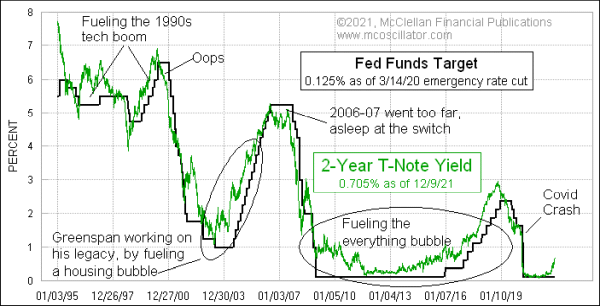
The Federal Reserve Open Market Committee (FOMC) is still stuck at 0-0.25% as its target for the Fed Funds rate. This is the interest rate at which commercial banks lend each other money overnight to balance their deposits and loans. The New York Federal Reserve Bank is tasked with the mission of intervening with more or fewer reserves in order to nudge the effective Fed Funds rate closer to the target rate every night.
Over the past few decades, we have found that the 2-year T-Note yield gives the best leading indication for what the Fed Funds target rate should do. We have also found that the FOMC does not do a particularly good job of listening to that message. They are always late in making the needed adjustments that the 2-year yield tells us are necessary.
The FOMC has still yet to act to raise its target rate, but the 2-year T-Note yield is not waiting, and has already risen to 0.705%. It is normal for the 2-year T-Note yield to move first and for the Fed Funds target to follow afterward, especially when the spread between the two gets really big. That spread is now putting more and more pressure on the Fed to do its job and raise their target rate. The longer that the FOMC has waited, and the wider the spread has gotten, the worse the damage has been to the financial markets.
In the mid-2000s, Alan Greenspan wanted to make sure that the economy recovered fully from the second Persian Gulf War in 2003, and so he kept the Fed Funds target rate lower than it should have been for too long. The result was an overstimulation of the housing market bubble that was happening then. Eventually the FOMC woke up to the reality it was facing, and got its target rate up to where it had needed to go.
The problem was that the FOMC left it there for too long, ignoring the message of the 2-year yield which topped at 5.28% in June 2006. That was long before the stock market’s final top in October 2007. And the FOMC did not wake up to the problem for a long time, keeping the Fed Funds target rate at 5.25% until September 2007. By that time, the 2-year yield was already down to 3.97%, showing just how far behind the times the Fed was.
The spread now is not quite that big, but it is screaming higher, putting more and more pressure on the Fed to act. I’m a lot better at declaring what the Fed should do than at determining what they actually will do. Economics and market forces are a lot easier to determine than the decisions of 12 humans. Every day that the FOMC waits to raise rates, and leaves a big spread between the Fed Funds target and the 2-year T-Note yield puts additional pressure on the financial markets and the banking system. Hopefully the FOMC this time will not wait as long as it has in past cycles. But that is a hope that does not have much evidence in history to back it up.
Tom McClellan
Editor, The McClellan Market Report